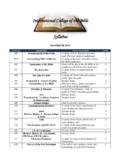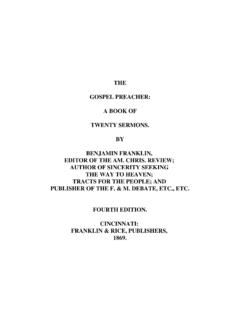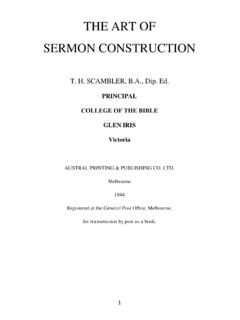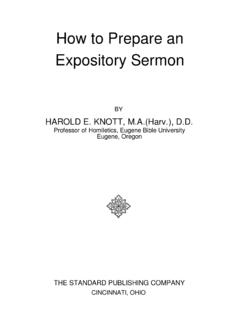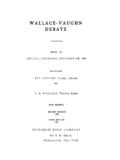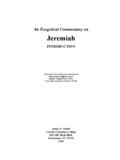Transcription of An Exegetical Commentary on Lamentations - ICOTB
1 1 An Exegetical Commentary on Lamentations James E. Smith Originally published in the Bible Study Textbook Series, College Press, 1972. Revised Edition 2006 2 INTRODUCTION TO Lamentations Lamentations is one of those Old Testament writings which has yet to receive its full share of recognition and appreciation by the Christian world. The reason for the neglect of this little book is not difficult to discover. In the popular view Lamentations is a somber and gloomy record of unrelieved grief as Jeremiah weeps over the ruins of Jerusalem. When viewed in this manner there is little about Lamentations that would attract the Bible student. However, the book is much more than a cheerless protest of the inequities of life. It is more than a cloudburst of grief, a river of tears, a sea of sobs as one writer has called it.
2 This five-fold poem is really an affirmation of faith in the justice and goodness of God. The author has tasted the bitter dregs of pain and sorrow, of cruelty and ignominy, of frustration and loneliness and yet he dares to cling to a faith undaunted, a faith which triumphs over circumstances. The book endeavors to explain history and place calamities in proper perspective. When the true purpose of Lamentations is recognized this amazing little book has a great deal to contribute to a Christian understanding of war and natural catastrophes. TITLE AND POSITION Like several other OT books Lamentations originally took its title from the first Hebrew word of the book. The book is called Ekah which is an exclamation expressing sorrow and sympathy.
3 Ekab in English may be translated alas or how sad it is. The same Hebrew word also introduces the second and fourth chs of the book. Later Jewish teachers referred to the book by another Hebrew title calling it Qinoth or laments. It is still known by this title in the Babylonian Talmud. The scholars who translated the Old Testament into Greek during the intertestamental period entitled the book Threnoi, the Greek word meaning Lamentations . At still a later time in the Greek, Syriac and Latin versions of the Old Testament the longer title The Lamentations of Jeremiah was applied. Though evidence is somewhat scanty it would seem that Lamentations was originally considered by the Jews as an appendix to the Book of Jeremiah.
4 The Jewish historian Josephus at the end of the first Christian century stated that the Hebrew Bible consisted of twenty-two books five books of law, thirteen books by prophets and four books of songs and hymns. 1 According to the Jewish method of counting, 1-2 Samuel were one book as were 1-2 Kings and 1-2 Chronicles. The twelve Minor Prophets were counted as one book and Ezra-Nehemiah were counted as a single book as well. Taking all this into account one would still have a total of twenty-four books instead of the twenty-two mentioned by Josephus. The only method of arriving at the figure twenty-two is to count Jeremiah- Lamentations as one book and Judges-Ruth as one. It is interesting that several of the early Church Fathers also speak of the twenty-two books of the Hebrew At some point subsequent to the time that Josephus wrote (AD 90), several books were removed from the prophetic division of the canon and assigned to the third division which was called in the Hebrew the Kethubhim ( Writings ) and in the Greek the Hagiography ( Holy Writings ).
5 The Book of Lamentations was at that time removed from its position as an appendix to the Book of Jeremiah and was counted as part of the third division. Lamentations was placed alongside of Ruth, 1 Josephus, Agaimt Apion I. 8 , Melito of Sardis ( 180), Origen ( 250), Augustine ( 420), and Jerome ( 405). 3 Esther, Ecclesiastes and Song of Solomon. Collectively these five little books became known the Megilloth, the Five Rolls. Already as early as the writing of 2 Esdras (ca. AD 100) this switch in the position of Lamentations seems to have taken place. This is indicated by the fact that the author of 2 Esdras gave the total of books in the Hebrew Bible as twenty -four meaning that Ruth had been severed from Judges and Lamentations from Jeremiah.
6 BACKGROUND AND OCCASION The destruction of Jerusalem in 587 BC was without doubt the most significant event to transpire in the political and religious history of Israel since the Exodus from Egypt. Scarcely any room for doubt exists that it was this momentous event which, on the human side, precipitated the writing of the Book of Lamentations . In retaliation against the rebellion of his vassal king Zedekiah, Nebuchadnezzar had laid siege of Jerusalem for eighteen long months. Lamentations describes in the most vivid manner the terrible suffering to which the Jews were subjected during the siege. When the city finally was captured the Chaldean king ordered it completely demolished. To see their beloved sacred city go up in flames was a shocking even stupefying experience.
7 In spite of the incessant preaching of the prophets who warned of this very thing, the Jews were totally unprepared for it. For over a hundred years since the miraculous deliverance of Jerusalem in the days of King Hezekiah the popular notion had been that Jerusalem was inviolable and secure. Events had demonstrated the basic premise of their theology to be false. Added to the tremendous burden of their grief over what had befallen their nation was their feeling of having been utterly rejected by God. THEME AND CONTENT Lamentations is a sad book. The basic theme of the book is a lament over the terrible woes which have befallen sinful Judah and the destruction of the Holy City and the Temple of God. The book consists of four dirges (chs. 1-4) and one prayer (ch.)
8 5) which were written in those agonizing days following the capture and destruction of Jerusalem. As one reads the book he can sense the depths of despondency into which the people had fallen. In these proms the poet has attempted to capture the mood of the people. This was not particularly difficult for him to do since he seems to have been personally involved in their suffering. For the most part the poems contain descriptions of the plight of the people, their land and their sacred city. Here and there are confessions of sin, declarations of penitence, and appeals for divine aid. Outlining the Book of Lamentations is somewhat difficult because the theme does not show significant variation from one ch to another. The outline used here has been adapted from that of C.
9 Paul 1. A Widowed City 1:1-22 2. A Broken People 2:1-22 3. A Suffering Prophet 3:1-66 4. A Ruined Kingdom 4:1-22 5. A Penitent Nation 5:1-22 FORM AND STRUCTURE 3 The Lamentations of Jeremiah, in vol. IV of Beacon Bible Commentary (Kansas City: Beacon Hill Press, 1966). 4 Lamentations is written entirely in poetic form. Hebrew poetry as a rule does not involve rhyme but rather is a poetry of thought. The second and third lines of each verse will repeat the thought of the first line in different words (synonymous parallelism) or develop further the thought of the first line (synthetic parallelism) or negate the thought of the first line (antithetic parallelism). The metrical structure used in the Book of Lamentations is known as the Qinah or lament rhythm.
10 This is the meter most commonly used in the ancient Near East for chanting dirges over the dead or lamenting national calamities. In Qinah rhythm the second line of each verse is one stress shorter than the first line. As a rule in Lamentations the pattern is three stresses in the first line, two in the second, and three in the third line. This meter, practically obscured in English translation, becomes apparent as one reads the Hebrew text aloud. The four dirges in the Book of Lamentations are in the form of alphabetic acrostics in which the author begins each verse with successive letters of the Hebrew alphabet. Chapters 1, 2 and 4 have twenty-two vv, one for each letter of the Hebrew alphabet. Chapter 3 contains sixty-six vv since three vv are assigned to each Hebrew letter.

